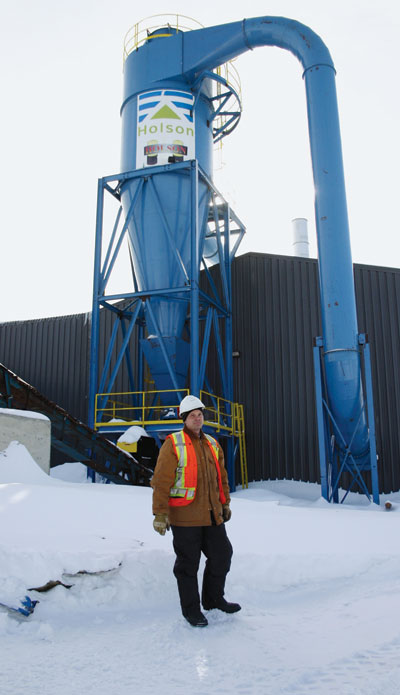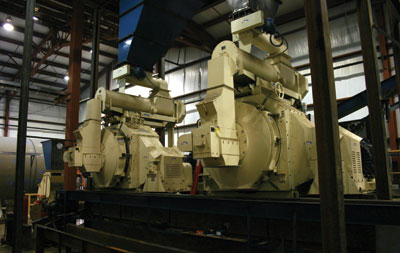
Wood Energy Provider
April 1, 2011
By
Heather Hager
As Todd May knows well, there are advantages and disadvantages to existing off the beaten track.
As Todd May knows well, there are advantages and disadvantages to existing off the beaten track. Business establishment can cost a little more and take a little longer. However, the location of Holson Forest Products near the northern end of Newfoundland’s Northern Peninsula presents it with an ample supply of fibre and puts it in a position to supply the regional market in a timely and cost-effective manner.

|
|
| A large, fenced wood yard, established with the help of a $1.18-million investment from the Atlantic Canada Opportunities Agency, kept loggers in business while the sawmill expansion and pellet plant construction were in progress. Photo: Todd May |
Holson Forest Products was started in 2004 by Ted Lewis, owner of Lewis Logging. Lewis started as a harvesting contractor who “owned a pickup truck and a chainsaw,” says May, general manager of Holson’s pellet division. Now, the company owns or controls 70% of the raw material in two forest management units on the Northern Peninsula, giving access to about 110,000 cubic metres/year of wood.
Holson Forest Products began as a small sawmill, producing 2 million board foot/year of sun-dried or green lumber. That changed in 2010, when the sawmill expanded to 10 million board foot/year capacity and added a drying kiln and a pellet plant. With 35 employees and many others directly or indirectly supported through harvesting, trucking, and other functions, Holson is the biggest employer in a region that has been hit hard by declines in the fishing and pulp and paper industries.
“Ten years ago, there were three pulp and paper mills in Newfoundland. Today there’s one, with two machines running,” explains May. “We had to harvest pulp wood in the province in order to produce lumber.” But in 2008, the pulp mill that previously had purchased all of the pulp-quality roundwood that Holson supplied no longer needed that wood. That meant developing a whole new business plan to keep the forest industry alive in the region, this time with a focus on lumber and wood energy, rather than pulp.
May says that Holson received financing in August 2009 to expand and upgrade the sawmill and build a 50,000-tonne/year pellet plant. Meanwhile, the company continued to purchase and stockpile sawlogs and pellet-quality roundwood from its harvesting contractors “to keep the workforce and harvesting expertise in the region.” The sawmill upgrade was completed and producing in early summer 2010, drawing from the stockpile of sawlogs. Waste fibre byproduct from the sawmill and about 40,000 cubic metres of stockpiled roundwood supply the pellet plant.
Single production flow
All fibre for the pellet plant is processed through the upgraded sawmill. “Depending on if we’re producing a white-wood pellet or an industrial-grade pellet, it will either be debarked (white-wood) or bypass our debarker (industrial) and go straight to our chipper,” explains May. “We didn’t see the need in installing a separate chipper and debarking system; there’s one at the sawmill, and the plants are already interconnected.”
 |
|
| At an earlier stage of construction, the M-E-C dryer was one of the first components to be installed. Photo: Todd May
|
Bark moves to the pellet plant via conveyor and is used for fuel and industrial-quality pellets. The fuel material passes through a wood hog and into a storage bin. From there it’s metered into a 40 million BTU bark burner supplied by KMW Energy, which heats an M-E-C triple-pass dryer.
Sawdust and chips for white-wood pellets are sent to the pellet plant by a blower. “We decided to blow our sawdust and chips up past our pellet plant and then feed it back in through the building so we have better control of how much material’s coming in the building,” says May. A conveyor system then takes the material past magnets that remove ferrous metal. A screen removes the oversized material and diverts it to a Schutte-Buffalo hammermill while undersized material bypasses the first hammermill and goes directly into a hopper that feeds into the dryer. Dried
material passes through the primary cyclone to a second Schutte-Buffalo hammermill and then into another hopper that feeds two Andritz pelletizers. The newly formed pellets move to a Geelen cooler and then a BM&M screen, which removes fines.
Finished pellets are either sent for bulk shipments or for bagging on a form-fill-seal bagging line from Premier Tech. There’s plenty of storage space for bagged pellets on skids, says May. He admits that there isn’t much bulk storage space, a challenge that he’s looking to address in the spring.
 |
|
| Exiting the dryer, the moist exhaust gases pass through a primary cyclone, which removes particulates and expels the spent exhaust to the atmosphere. Photo: Juris Graney
|
The plant was designed by engineer Van Wall of Projitech, out of St.-Georges, Quebec. “All the way through the design process, we’ve been very cognizant of fire and explosion and ensuring that we’re protected, either through venting or detection/suppression systems wherever there’s risk of fire,” states May. That includes Firefly spark detection/suppression and a reversing screw at the primary cyclone that can divert the material to a bin outside the building if a fire is detected. The whole pelleting process is coordinated via a control system installed by Logitex, out of Quebec.
Commissioning of the plant was originally expected in November 2010, but production is now slated to begin in late March 2011. Issues related to the remote location, bad weather, and interruptions in ferry service delayed the arrival of some of the smaller pieces of equipment, says May. “We are located 350 km from the Trans-Canada Highway,” he notes. That means no overnight deliveries from a courier service that arrives once a week. “It’s something that we’re accustomed to, and we know how to work around it. A lot of our regular suppliers are used to shipping something to another supplier or another company in Deer Lake or Corner Brook, and we arrange to have it picked up from there. And that’s a bit of a learning curve for some of our new suppliers.”
Regional energy provider
Despite the challenges, Holson’s location on the Northern Peninsula is allowing it to pursue a wide diversity of pellet customers. First, there’s the potential to ship pellets overseas from the nearby ports of St. Anthony or Roddickton, and May says they have had discussions with a couple of European clients who are looking for bulk pellets.

|
|
| Holson’s 50,000-tonne capacity pellet plant has two Andritz pellet mills. Photo: Juris Graney, The Northern Pen
|
Then there’s the home heating market. Although this would involve smaller quantities, May says: “Our winter lasts from September until the end of May, really, so we’ve got a very long heating season.” But the idea is not just to supply pellets. “We’re in the process of becoming an installer and supplier of residential burner and boiler systems,” he says. “We feel that there’s an opportunity for a fairly large market in Newfoundland once we actually prove ourselves.”
Finally, Holson Forest Products is taking an approach that’s new to Canada: it’s looking to become an energy supplier for industrial, commercial, and institutional buildings, as well as for remote communities that lack access to the power grid. “We’re looking to be an energy provider. We’re actually working to do those boiler conversions, selling the heat to facilities versus just selling pellets. So we would actually own and operate the boiler systems,” explains May. In fact, Holson is in negotiations with a couple of industrial sites that would require process steam and hot water year-round. It is considering four potential boiler suppliers, three in Canada and one in Ireland, for the most suitable system. “This time next year, we want to have at least one, if not three, commercial facilities that are going to be converting from oil to our pellets. We will own those and supply our pellets; we will sell the customer the energy.”
May also sees the potential for small-scale combined heat and power production. Although most communities in Newfoundland are connected to the power grid, he says there are many small, isolated communities in Labrador that have no access to the grid and are reliant on diesel generators. “We’ve been working with a couple of community groups and talking with them about potential power generation on a smaller scale,” he says. “It’s been fairly preliminary at this stage, but there is certainly potential for it.”
Print this page